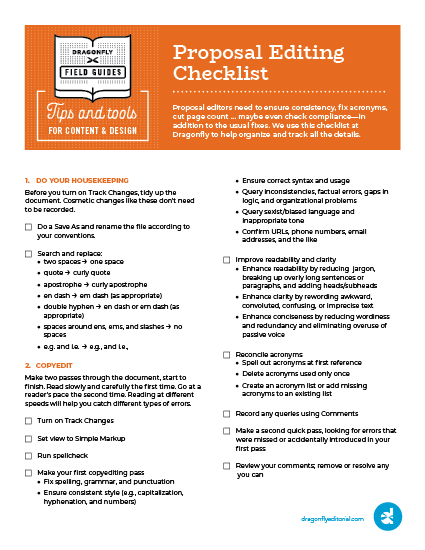Proposal editors need to ensure consistency, fix acronyms, cut page count … maybe even check compliance—in addition to the usual fixes. A checklist can help. At Dragonfly, this one has helped us increase the quality and consistency of our editing. We hope it helps you, as well.
1. Do your housekeeping
Before you turn on Track Changes, tidy up the document. Cosmetic changes like these don’t need to be recorded.
- Do a Save As and rename the file according to your conventions.
- Search and replace:
- two spaces ➞ one space
- quote ➞ curly quote
- apostrophe ➞ curly apostrophe
- en dash ➞ em dash (as appropriate)
- double hyphen ➞ en dash or em dash (as appropriate)
- spaces around ens, ems, and slashes ➞ no spaces
- e.g. and i.e. ➞ e.g., and i.e.,
2. Copy edit
Make two passes through the document, start to finish. Read slowly and carefully the first time. Go at a reader’s pace the second time. Reading at different speeds will help you catch different types of errors.
- Turn on Track Changes
- Set view to Simple Markup
- Run spellcheck
- Make your first copyediting pass
- Fix spelling, grammar, and punctuation
- Ensure consistent style (e.g., capitalization, hyphenation, and numbers)
- Ensure correct syntax and usage
- Query inconsistencies, factual errors, gaps in logic, and organizational problems
- Query sexist/biased language and inappropriate tone
- Confirm URLs, phone numbers, email addresses, and the like
- Improve readability and clarity
- Enhance readability by reducing jargon, breaking up overly long sentences or paragraphs, and adding heads/subheads
- Enhance clarity by rewording awkward, convoluted, confusing, or imprecise text
- Enhance conciseness by reducing wordiness and redundancy and eliminating overuse of passive voice
- Reconcile acronyms
- Spell out acronyms at first reference
- Delete acronyms used only once
- Create an acronym list or add missing acronyms to an existing list
- Record any queries using Comments
- Make a second quick pass, looking for errors that were missed or accidentally introduced in your first pass
- Review your comments; remove or resolve any you can
3. Run a horizontal quality check
Now, instead of reading the document top to bottom, skip from one similar section to another, looking for consistency across the document.
Check front matter.
- Are volume numbers and names correct?
- Do they match what’s in the header and footer?
Check all cross-references.
- Are references to other sections, volumes, attachments, or appendices correct?
Check exhibits.
- Are titles and action captions correctly capitalized and punctuated?
- Is numbering correct and consecutive?
- Does each exhibit have a callout, correctly numbered?
Examine bulleted lists. Does each have:
- Correct end punctuation for the introductory sentence?
- Correct punctuation for each bulleted item?
- Items worded in a parallel manner?
Fix the table of contents.
- Are all entries correct?
- Are all page numbers correct?
Ensure correct, consistent formatting across:
- Headers and footers
- Page numbering and section numbering
- Font type and size
- Use of italics and boldface
- Margins, leading, and justification of text
If there’s a bibliography, check:
- Consistency of reference list with given style
- Consistency of in-text citations with given style
- Agreement between citations and reference list
Finish up
Almost done! These last few steps will help you catch errors inadvertently entered in the text.
- Turn off Track Changes
- Run a final replace of two spaces ➞ one space
- Run a final spellcheck
- Do a final Save, and you’re done!


